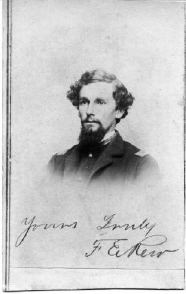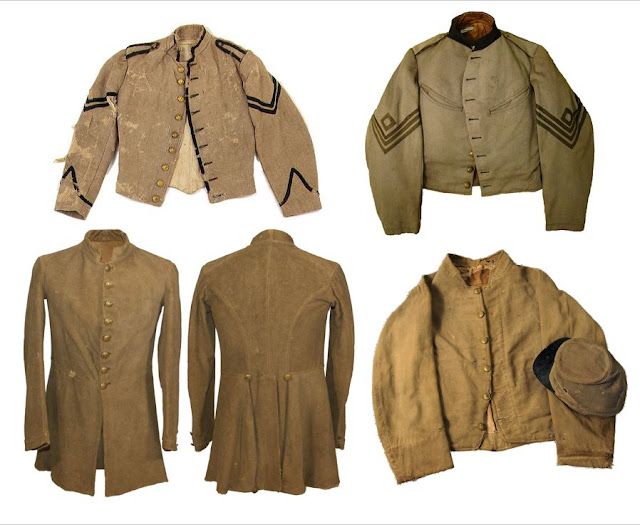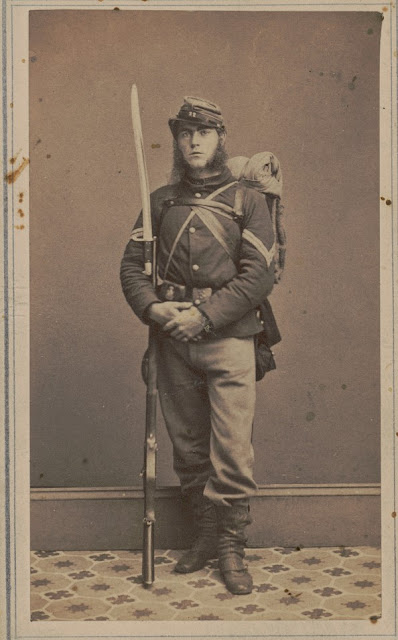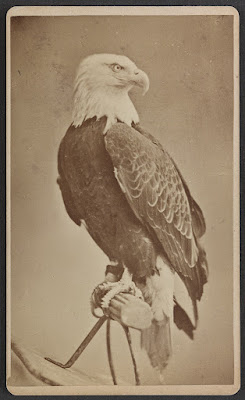The Perfect Trap at Yorktown: A Vermont Survivor’s Tale
Sergeant Frank Rew of the 3rd Vermont served with the Army of the Potomac from its beginnings through Appomattox, but his first harsh introduction to combat didn’t arrive in a large battle but in a fierce skirmish that took place on the siege lines of Yorktown in April 1862.
Four companies of the 3rd Vermont
were tasked with crossing the Warwick River at Dam No. 1 and seizing the Confederate rifle pits beyond which their commanders thought had been abandoned. They were quickly
disabused of the notion. “The creek is about six rods wide and into it the
brave fellows dashed, some sinking to the waist and others to the arm pits
which of course wet much of our ammunition," Sergeant Rew recalled. "When about midway, the Rebels
poured in a blinding volley upon them, mowing them down like grass, but on
rushed the rest in the face of 3,000 enemy riflemen and dashing up the bank
drove a whole regiment from their first rifle pit. The odds were too fearful
and every man knew he was fighting against hope. The order to retreat not being
heard amid the din of battle, they fought on and held the trench they had
captured for 15 minutes when the order was again; this time, they fell slowly
back.”
This brief action cost Rew’s company 27 men killed, wounded, and missing. “I went down at the first firing of musketry and helped bring in our wounded. Such a sight I never beheld before. General Brooks says the order was not designed to storm and take the enemy’s works but for a forced reconnaissance and then to fall back, but our men thought it was for that purpose and were bound not to stop short of it.”
Sergeant Rew’s riveting account of what became known as the Battle of Lee's Mills first saw publication in the May 3, 1862, edition of the Waukegan Weekly Gazette, shared with the editors of that newspaper by his parents who were then living in Lake County, Illinois.
Before
Yorktown, Virginia
April 17, 1862
My dear
parents,
You will see by my handwriting that I
am still in the land of the living, but how fortunate I am to have been thus
spared while my poor company is all cut up. Only twelve of those who went over
that fatal creek came out unscathed. But two officers were wounded; Captain [Samuel E.] Pingree received a wound in the hip and had his right thumb shot away besides
many holes in his clothes. Lieutenant Chandler received a ball in one leg and
another in his right hand. French came out sound though he had many close
calls. As he was loading his gun, a ball struck the bayonet and glanced by his
ear else it would have struck him in the face. His clothes were riddled.
Now you want to know the particulars
of the fight. Yesterday morning, our brigade was ordered to the front followed
by two batteries. The latter opened on the enemy’s works and silenced several
guns. No demonstration was made by the infantry until 3 p.m. when an order came
to the 3rd Vermont to send two companies over the creek as the
Rebels were supposed to have been driven from their rifle pits in front. Six
companies of our regiment had been deployed as skirmishers and those remaining
were Cos. D, E, F, and K. Cos. D and F were chosen to charge across the creek
with Cos. E and K in support.
The creek is about six rods wide and
into it the brave fellows dashed, some sinking to the waist and others to the
arm pits which of course wet much of our ammunition. When about midway, the
Rebels poured in a blinding volley upon them, mowing them down like grass, but
on rushed the rest in the face of 3,000 enemy riflemen and dashing up the bank
drove a whole regiment from their first rifle pit. The odds were too fearful
and every man knew he was fighting against hope. The order to retreat not being
heard amid the din of battle, they fought on and held the trench they had
captured for 15 minutes when the order was again; this time, they fell slowly
back.
The Rebels having gained their second rifle pit had again
sent their leaden hail upon them in a perfect storm with deadly effect.
Lieutenant Buck of Co. D attempted to rally the men after they reached the
first rifle pit and make a dash on the second; as he leaped on the other side
of the trench, one of our boys named Eldridge (a noble fellow) raised himself
upon his elbow and said with a smile, “We would follow you if we could, but we
are all wounded here,” and fell back. Another of our company named Moses George,
fell with both legs broken, but took our cartridges and tore them open for the
other boys to load, encouraging them until they were all down and no one left
to use them. There were many similar cases of bravery I could mention if time
permitted. Their praise is in everyone’s mouth.
The Rebels had laid a perfect trap; one regiment being in
front and two on each flank which formed three sides of a hollow square with
our poor boys in the center. How a man escaped I am at a loss to tell unless
the enemy thought it was a decoy and dared not follow. Nearly 100 of the four
companies of our regiment are either killed, wounded, or missing. The missing
are all on the other side of the creek, whether killed or prisoners is not
known. We have 52 wounded men in the hospital who are well cared for.
I went down at the first firing of musketry and helped bring in our wounded. Such a sight I never beheld before. The 6th Vermont was ordered down during the engagement and attempted to cross but were repulsed with the loss of 100 men. I also assisted in getting off the wounded. General Brooks says the order was not designed to storm and take the enemy’s works but for a forced reconnaissance and then to fall back, but our men thought it was for that purpose and were bound not to stop short of it. Last night, our forces threw up works, bearing on the enemy’s fortifications and today the men have been busy in filling sandbags. By tomorrow I presume they will be ready to resume the work of death. We have moved our camp 1-1/2 miles today nearer the enemy’s works. I am very tired having been with the wounded all day. If it is the will of God, I shall still be preserved; if not, His will be done. Will write again soon.
 |
| At Lee's Mills, the 3rd Vermont was under the command of Brigadier General William Farrar "Baldy" Smith who led a division. |
Camp
Winfield Scott, Virginia
April 21, 1862
My dear
parents,
We are occupying the same position as
when I last wrote but every day has its excitements and time flies rapidly. The
loss in our company proves to be 27 killed and wounded, not as bad as at first
supposed and 83 in the four companies that went over the creek. Fortunately, 20
of our company were out as skirmishers, hence did not go over. We have but 56
men- Captain Pingree and Lieutenant Chandler will go home on furlough until
able to resume their duties. Their wounds were not dangerous.
We had an exciting scene the day
before yesterday which I must say reflected more honor on the Rebels than us.
The day after the fight, Quartermaster Craine asked permission to go down under
a flag of truce and bury our dead and help our wounded if any remained; this
General McClellan did not grant. On the third day, white flags were raised on
the enemy’s works which created some excitement along our lines. I climbed a
tree where I could see the meeting of the flags. Major Curry, A.A.G. to General [William F.] Smith, went down from our side and was met by the colonel of the 2nd
Louisiana. They asked for a cessation of hostilities for two hours for the
purpose of burying our dead. Of course, they had none of their own to cover.
The men had fallen on their side just under their works and our sharpshooters
would not let a man show his head. I say, this does the Rebels credit for they
made the first offer which in itself was humane.
But to return, General Smith would not
accept their first request, but asked permission to go over and do the work
ourselves. After due consultation, they agreed that the Rebels should bring the
bodies partway across the dam and we should receive them and bring them away.
The orders were very strict as to who and how many should go. Only 4 wagons and
20 men were allowed. The stipulations were that neither side should take
advantage of the truce for reconnaissance, hence the men were not permitted to
come to the front nor any glasses allowed in our party. A captain and
lieutenant were in charge besides the colonel with the flag; Quartermaster Craine
also was in our party.
Some 50 Rebels were employed to bring
our poor boys over, all of whom we saw face to face in their wild state. I will
make no comment on the revolting task of receiving the bodies, enough to say it
was awful for they had lain three days in the hot sun and were so changed that
I could recognize but four of our men, one was a sergeant. They brought over 29
bodies in all, 22 belonging to our regiment and the rest of the 6th
Vermont. The retained four of our wounded men as prisoners.
 |
| Sgt (later Lt) Frank E. Rew Co. F, 3rd Vermont |
We remained together for an hour while
waiting for teams which gave us the opportunity for conversation. They were
very courteous and even talkative. I found several quite intelligent fellows,
one in particular from Georgia. We had a social time, exchanged buttons, and
shook hands warmly when separated. How much cordiality he felt I cannot tell
but presume he concluded I was half secesh. I had an object, however, and
gained some important facts by the means. Some of their men were well dressed
and others quite destitute.
I conversed sometime with a Kentucky fellow who was downcast
and nearly sick of his job. Our forces have possession of his old home and he
is without friends or means. I asked one man what thought of the Yankees taking
boats around Island No. 10 on dry land? He acknowledged it was a fine truck but
said we could not run our boats through their works here on dry land and asked
what I thought of their fortifications. I was obliged to acknowledge them very
formidable which is really the fact. They were all fast for trading something
with our men and most all brought away something of a trophy.
Our sharpshooters are doing a grand work here and are a great terror to the Rebels. Every night, our troops throw up entrenchments and now we have three fine forts which when they are opened will no doubt reduce those before us. It was a saucy trick to build these works right under the enemy’s guns. Our whole line is entrenching strongly and the whole army are using the shovel and axe. Not a night passes without heavy volleys of musketry being fired back and forth and at intervals the big guns will open. Be assured this is music, yet I hardly think the general ball will open just yet. I had little idea of a real siege until I witnessed it here. Yesterday and today, it has rained hard yet the work goes on.
Source:
Letters from
Sergeant Frank E. Rew, Co. F, 3rd Vermont Volunteer Infantry, Waukegan
Weekly Gazette (Illinois), May 3, 1862, pg. 2












Comments
Post a Comment